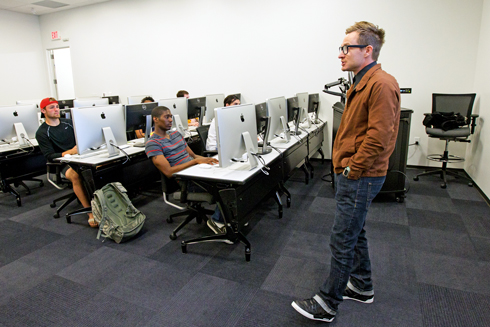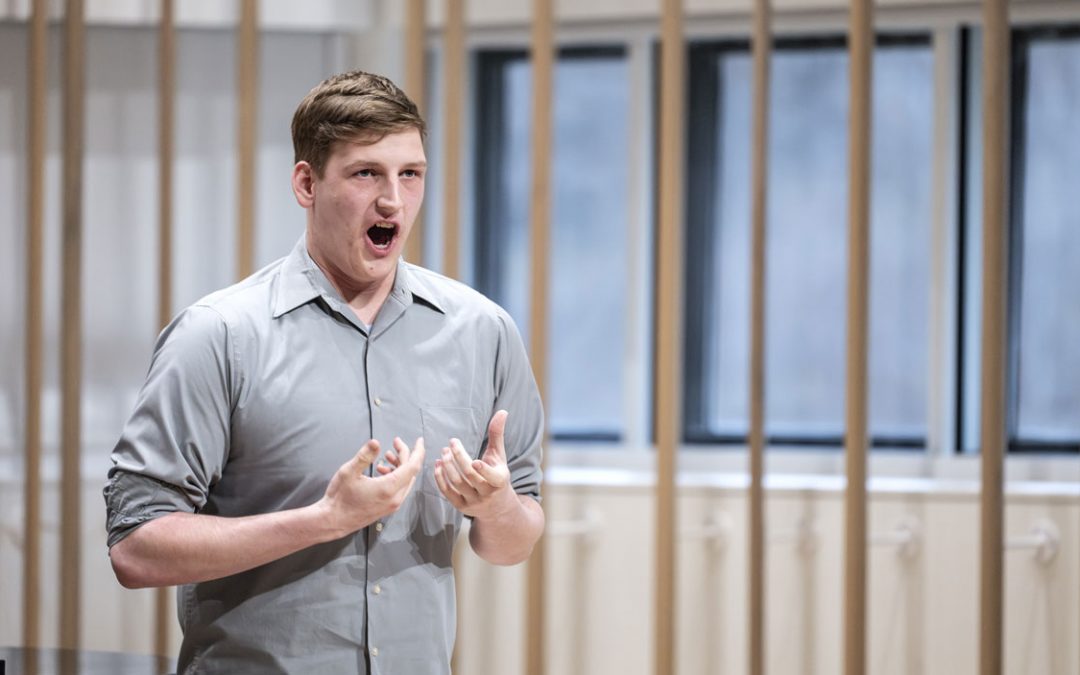
UMSL Assistant Professor of Media Studies and Art BC Biermann (right) teaches his students about augmented reality and other emerging media from the university's newest building – UMSL at Grand Center. (Photo by August Jennewein)
BC Biermann peers at his smartphone’s screen as he points the phone’s camera lens at a graphic design projected on a classroom wall. Students huddle behind him to get a look at the display. Through the phone, the static image on the wall suddenly comes to life. An airplane flies. Words flow into view. Cars roll along a street.
This overlaying of virtual objects and information on the real world is known as augmented reality. Biermann not only produced the classroom AR content but studies and teaches AR and other emerging media as an assistant professor of media studies and art at the University of Missouri–St. Louis.
“My academic interest is really in art and public space,” he says. “So, I use technology as a way to bring ideas or concepts to bear in reality.”
Re*public is an AR project that Biermann created along with two colleagues from New York. The project explores how technology and creativity can re-imagine public spaces. The trio designed an experimental software application for mobile devices that enables smartphone and tablet users to resurface physical buildings in urban centers by overlaying digital content onto the physical environment.
“[AR] allows us to engage public spaces in a way that’s legal,” he says. “We can put art on buildings that we couldn’t do physically.”
About a dozen students are taking Biermann’s first course at UMSL this semester. It’s called “Fundamentals of Emerging Media,” and he’s teaching in one of the classrooms in the Monsanto Community Education Center at UMSL at Grand Center. The students are learning about the mobile Web, mobile Web applications, AR and video projection mapping.
Prior to taking the position at UMSL, Biermann worked in Southern California as a university professor and tech developer. He says he was attracted to the job here because emerging media is a new academic offering from the College of Fine Arts and Communication, and he wants to help mold the courses.
“They were looking for someone to guide the new program in new media, and really get into the program on the ground floor,” he says. “To have a chance to be really creative and build a program was exciting to me.”
He also was won over by being part of a new facility with top-notch technology and by the building being located within Grand Center, a district in St. Louis’ Midtown neighborhood and a hub for the arts, entertainment and public media.
“To have access to other media outlets, other creative cultural institutions and other private design companies is very important,” he says. “To create collaborative public-space art projects with these other institutions is definitely on my map.”
This story was originally published in the fall 2012 issue of UMSL Magazine.














